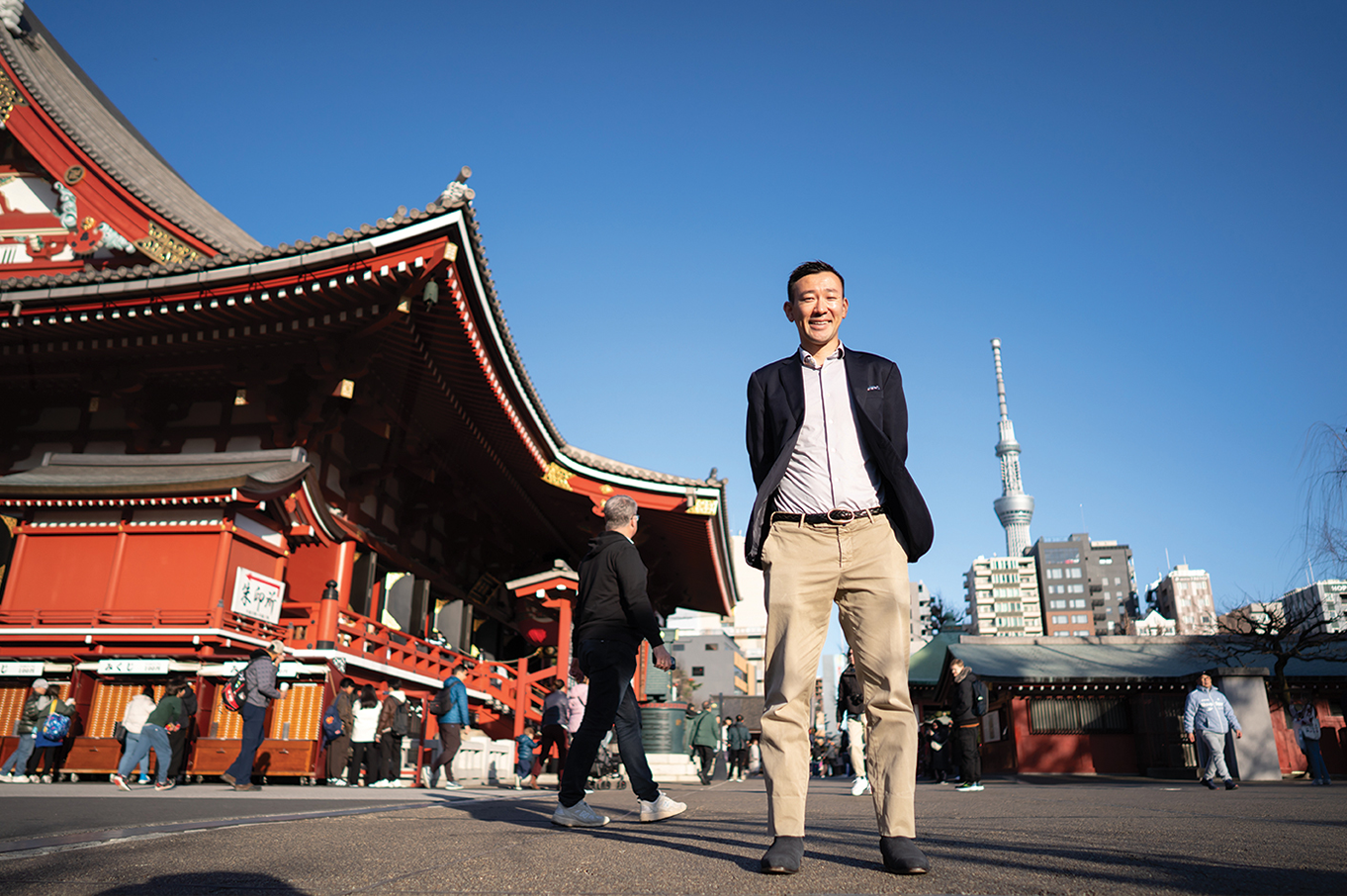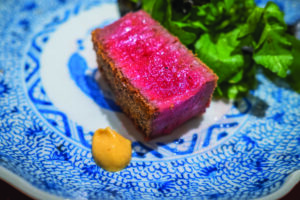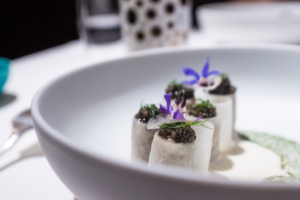Show us your town: Tokyo
Show us your town: Tokyo
Entrepreneur Yohay Wakabayashi ’10, ’11S (MS) shares some of his favorite things to do in one of the world’s top destinations for culture and cuisine.

HOMMAGE TO TOKYO: Japan’s capital is experiencing a culinary heyday, with cornucopias of tasty street food and more Michelin-rated restaurants in 2023 than Paris and New York combined. Among those is Hommage where, incidentally, you can sample Wakabayashi’s Rococo Tokyo White—Japan’s first luxury beer.
Visitors love the Tokyo’s temples, shrines, and gardens. They savor its sushi, noodles, yakitori, and many culinary delights. And they soak up the city’s museums, nightlife, and shopping opportunities. For American tourists, it’s an ideal time to visit, too, says Yohay Wakabayashi ’10, ’11S (MS).
“The US dollar is very strong in Japan right now—the strongest it’s been in years—making it much more affordable for people to travel here,” says Wakabayashi, who frequently meets up with alumni and friends from the US. “I recommend that people visit now to experience all that Tokyo has to offer.”
Planning a visit and only have three days? Here’s how Wakabayashi—one of about 500 Rochester alumni in Japan—recommends you spend your time.
Day 1
 Begin your trip in Harajaku, a vibrant part of the city that’s full of vintage stores, street art, and youthful energy. Then, head to the Omotesando—a sophisticated area often referred to as Tokyo’s Champs-Elysee. Shop for souvenirs like tenugui (Japanese hand towels), washi (Japanese paper), pottery, textiles, and tea ceremony goods. Consider visiting the Ukiyo-e Ota Museum to admire traditional woodblock prints and the Nezu Museum of Fine Art, which houses a large collection of pre-modern Japanese and East Asian art and features a traditional Japanese garden.
Begin your trip in Harajaku, a vibrant part of the city that’s full of vintage stores, street art, and youthful energy. Then, head to the Omotesando—a sophisticated area often referred to as Tokyo’s Champs-Elysee. Shop for souvenirs like tenugui (Japanese hand towels), washi (Japanese paper), pottery, textiles, and tea ceremony goods. Consider visiting the Ukiyo-e Ota Museum to admire traditional woodblock prints and the Nezu Museum of Fine Art, which houses a large collection of pre-modern Japanese and East Asian art and features a traditional Japanese garden.
Then explore the Meiji Shrine. It’s a religious and cultural icon dedicated to modern Japan’s first emperor and empress. The shrine and its adjacent Yoyogi Park are nestled inside a 170-acre urban forest, which is home to 120,000 trees and offers a respite from the city. “Visit here and you’ll forget you are in the heart of Tokyo,” says Wakabayashi.
For dinner, Wakabayashi recommends Nishiazabu Taku for Edomae (Tokyo-style) sushi. “Sushi was created in Tokyo, so it is best experienced authentically in its birthplace,” he adds. “The chef prepares the sushi and presents it to you—it’s a very special experience.”
Day 2
 Explore traditional Tokyo in the Asakusa district. Start with a visit to the Tokyo Skytree, the world’s tallest tower, and take in a 360-degree view of the city. Then, wander through some of Asakusa’s craft shops. Pick up local items like as yukata (an informal style of kimono) and hashi (chopsticks). Try some street foods, too, such as gyoza (deep-fried dumplings), yakitori (grilled, skewered chicken), and taiyaki (fish-shaped snacks filled with sweet bean paste). Later, visit the Sensoji Temple, the oldest temple in Tokyo.
Explore traditional Tokyo in the Asakusa district. Start with a visit to the Tokyo Skytree, the world’s tallest tower, and take in a 360-degree view of the city. Then, wander through some of Asakusa’s craft shops. Pick up local items like as yukata (an informal style of kimono) and hashi (chopsticks). Try some street foods, too, such as gyoza (deep-fried dumplings), yakitori (grilled, skewered chicken), and taiyaki (fish-shaped snacks filled with sweet bean paste). Later, visit the Sensoji Temple, the oldest temple in Tokyo.
After a day of sightseeing, dine at Hommage, a two-star Michelin restaurant in Asakusa. The chef “blends modern French cuisine with authentic Japanese fare,” says Wakabayashi, calling dining there “an unforgettable experience.”
Day 3
 Spend your last day in West Tokyo. Take a walk around Nakameguro, a trendy neighborhood along the Meguro River that offers many taprooms, cafés, shops, galleries, and museums. From there, explore nearby Daikanyama. Its tree-lined, pedestrian-only streets are packed with boutiques, open-air eateries, and upscale architecture. Explore the stylish Tsutaya Daikanyama bookstore, too. “Be sure to go up to the second floor where you can enjoy a drink in a stylish lounge surrounded by rare vintage Japanese magazines,” he adds, noting that his beer—Rococo Tokyo White—is served there.
Spend your last day in West Tokyo. Take a walk around Nakameguro, a trendy neighborhood along the Meguro River that offers many taprooms, cafés, shops, galleries, and museums. From there, explore nearby Daikanyama. Its tree-lined, pedestrian-only streets are packed with boutiques, open-air eateries, and upscale architecture. Explore the stylish Tsutaya Daikanyama bookstore, too. “Be sure to go up to the second floor where you can enjoy a drink in a stylish lounge surrounded by rare vintage Japanese magazines,” he adds, noting that his beer—Rococo Tokyo White—is served there.
For dinner, visit Towa, a Kaiseki restaurant in Nishi Azabu, which features a traditional multicourse menu with wagyu (high-end Japanese beef ) as its signature item. Wakabayashi adds that Tokyo, in addition to being known for its sushi, is famous for wagyu. Time-permitting, take in a theatrical performance at the Kabuki-za in the trendy Ginza area nearby.

Meet your guide
Yohay Wakabayashi ’10, ’11S (MS) was born in Japan and spent 11 years in the US attending junior high, high school, and college. At Rochester, he majored in economics and stayed on to earn a master’s degree in strategic marketing at the Simon Business School. He also was a top scorer on the squash team.
Wakabayashi is a cofounder and CEO of Maison Rococo, which brews and markets Japan’s first luxury beer under the Rococo Tokyo White brand name (rococotokyo.com) and is available in restaurants, luxury hotels and ryokan in Japan, Taiwan, and Singapore.
Wakabayashi credits Rochester for helping him develop an entrepreneurial mindset, gain an appreciation for networking, and cultivate his strong work ethic. “Rochester taught me to never give up, taught me about grit, and gave me the skills to achieve my goals,” he says.
International networks and you
With more than 10,000 alumni living outside the US, the University offer networking groups in Japan, Canada, Chile, China, France, Germany, Guam and Indonesia, Guatemala, Hong Kong, India, Italy, Korea, Paraguay, Spain, Taipei, and the United Kingdom and Ireland. Learn more.
Tomohiro Ohsumi/AP images for the University of Rochester (Wakabayashi); courtesy of Maison Rococo (food)
— Kristine Kappel Thompson, Rochester Review, Spring 2024


